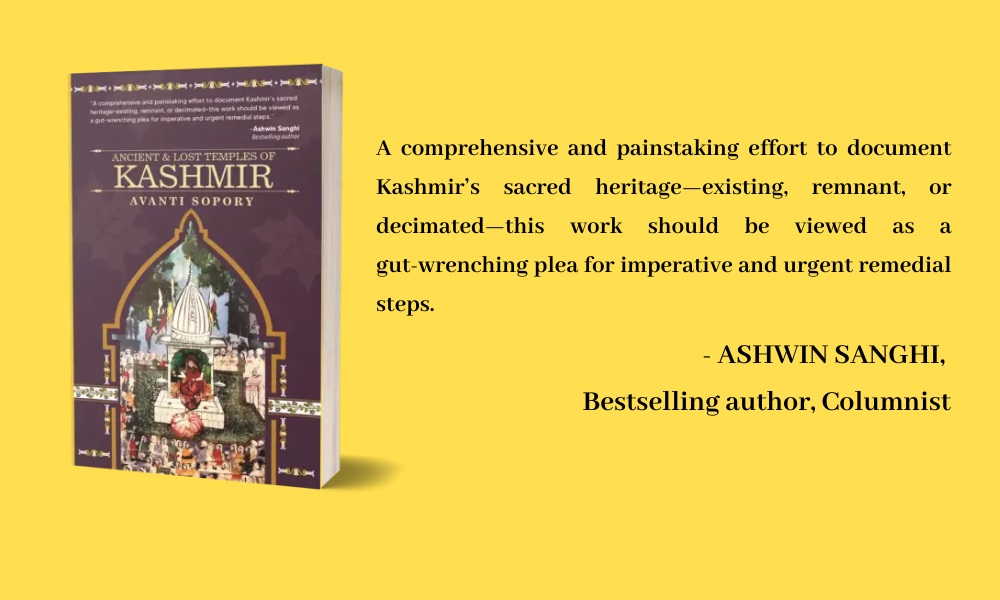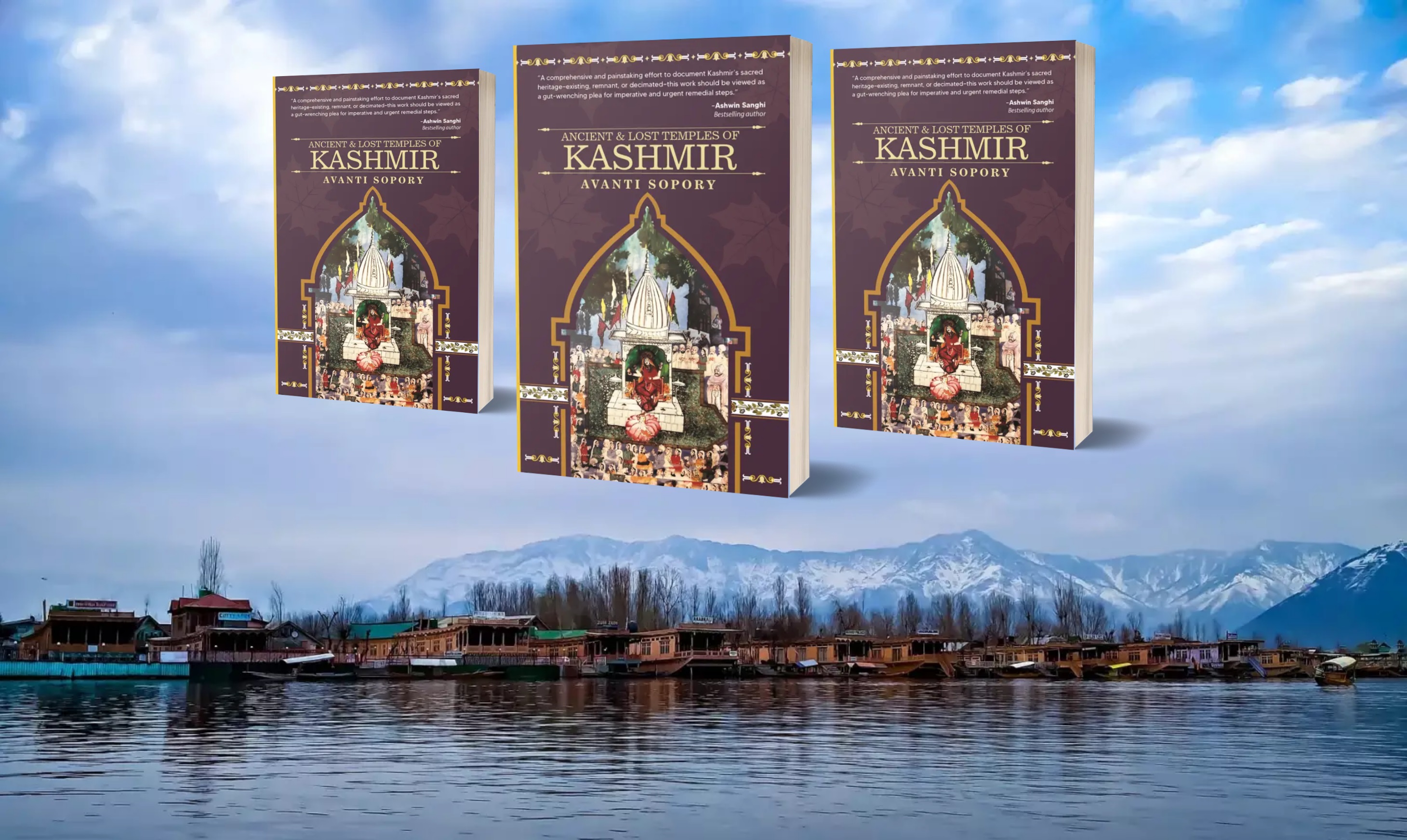Avanti holds a postgraduate degree in management. She started her professional career with CitiFinancial and then moved to teaching management students at Rai Foundation. Avanti has compiled a collection of folktales and stories from her native place Kashmir. Avanti has contributed articles for newspapers like “Young Minds”, “The Daily Latest” and “Kashmir Times”. You can read more about her here.
Readomania: Hi Avanti! Congratulations on the launch of your latest book Ancient & Lost Temples of Kashmir. We all know Kashmir as paradise on Earth. Its natural beauty is unparalleled. However, not many of us are aware of the temples in Kashmir. Was that your primary motive to write this book?
Avanti: Hi and thank you so much, Indrani for the wishes. My motive to write this book was more to do with the historical and cultural richness of Kashmir. The absolutely stunning religious monuments that were built 2,000 years ago, by engineers who must have been artistes too. The sheer beauty and the magnanimity of these buildings are a proof of the aesthetics of the people who lived then.
Exploring the cultural identity is also a way to preserve my past and the uniqueness of the valley…its people, lifestyle, religious identity and much more. This documentation is important because most of the ancient text has either been destroyed or lost due to negligence. If we don’t collate and correct our actions now, then who will do it?
And with this, I wish to get the attention of the authorities. It is their absolute responsibility that they restore and bring back the lost dignity to these ancient temples.

Readomania: You have done painstaking research to write this book. Getting logistical facts and figures about structures which were decimated centuries ago wasn’t an easy task surely. Do tell us about your research procedure.
Avanti: I began with a long exhaustive list of all possible temples, shrines, monuments and religious sites across Kashmir. Since my focus was only on Kashmir, I did not list the temples from the rest of Jammu and Ladakh region. I am sure there would be many temples there too. It was a very long list and the same temple was called by different names at different places. So I did that cleaning first…after this I had a concise list. Then I put these temples into sub-groups of the villages they belonged to. Then I put them in a chronological order and the dynasties under which they were built. This was just the beginning and it was already quite tedious.
Post this, I started the field job—the library visits, archived book retrieval, book reviews, intensive research, interviews, expert opinion, pictures, cross reference information, comparative analysis, collaboration between researchers and historians to ensure accuracy, archaeological reports, live reports, accessing digital resources, peer and expert review before submitting my manuscript, and mapping all these data points to ensure that the information I put in the book is authentic and correct to the last T.
Unfortunately, with respect to Kashmir, an enormous amount of data and priceless books, and scriptures have gotten lost. Centuries ago all the religious and cultural text was either burnt or dumped in the river. So can you see the colossal cultural loss we have suffered?
Readomania: Of all the temples you have documented, which one left you looking for more and why?
Avanti: There are plenty…Kothiarvan, Parihaspora, Avantiswami, Payar, Sharda…I mean by mere looking at these places you will feel their majestic imposition on you. I mean it’s like they have an air of authority and command even in the vacant and desolate spaces of these complexes. The spiritual depth and the historical vastness of these places… Mind blowing! We can’t even begin to fathom the centuries of cultural wealth that is saved and stored in the crevices and corners.
Readomania: For you, Kashmir is not just home that was lost; it is an emotion, a passion. You have written extensively on Kashmir. What is it about Kashmiri architecture that you feel stands out the most?
Avanti: Nag, Nagar-Nagar and Nagara, that’s how I would describe the temple architecture of Kashmir. Since Kashmir is blessed with many natural treasures, springs are a common thing there. These springs are called Nags in Kashmir and the etymology of Nags is different in Kashmir. While Nags is the Sanskrit name for a snake, in Kashmir the aborigines were a group of people who dwelled near these springs and were ardent worshippers of the snakes living in and near these springs and constructed Shiv temples next to the spring. Over time, these springs were started to called Nags and a Shiva temple was a sacrosanct prevalence near these Nags or springs. So all the Shiva temples in Kashmir have a Nag or a spring next to it.
As per Vaastu shastra, the popular temple of Haeri Parbat is located at the centre of the city. From this point onwards the Bhairav temples, and other temples are constructed around the Srinagar city. The foundation of this was laid by King Sri Pravarasena, who ruled over Kashmir around the 5th century. At that time his kingdom was called Nagar-Nagar, and many years later the Sri from the king’s name and Nagar from the old name were amalgamated to make Srinagar. The design of the design of the temple and the city was similar in some way to the Vaastu-compliant ancient city of Kashi.
Kashmir temples have a distinct style of the Nagara pattern of architecture, where the shikhars are taller, curvilinear, and bulbous, with large garbha grahas and courtyards, lot of fine stone carving, sculpturing, etc can be noticed at these temple structures.

Readomania: Ancient & Lost Temples of Kashmir is a non-fiction book. However, you have given it a unique treatment by using Kabir, a fictional character as the narrator. What made you add this twist?
Avanti: Well actually when I began writing this book, I had no plans of giving any such twist to it. My primary aim at that moment was to collect my data points, make visits and collect information. My entire focus was on the content and research. And while doing all this, I came upon a commentary by the renowned Acharya Abhinavgupta on Natyashatra by Bharatmuni. In the commentary, he explains the different Rasas, the emotion of anger, surprise, love, laughter, etc. and emphasizes on the importance of Rasas, or emotions in any literary work. This revealed upon me the need for an emotional sutradhar, someone who can represent me and handhold the reader. I had to find a way to string these architectural marvels, like pearls in a silken thread. That’s when Kabir comes into the picture. He takes the reader through all the temples...like a sutradhar. The introduction of Kabir filled this gap and the character gelled well with the flow of the book. He handholds the reader and the pause and the interactions he shows add to the progress of the book. His conversations bring a distinct warmth to the reader. For a moment it feels as though the reader is physically standing next to those magnificent temples.
Readomania: In the book, Kabir comes across many legends associated with the temples that he had either heard from his grandmother or from locals. Are there any mysteries you came across and as a child about the same? Do you remember any such intriguing stories?
Avanti: Well! There are plenty. Just a few walking steps from my house in Kashmir was a Bhairav temple, called Vitalraza Bhairav. I have mentioned about this Bhairav temple in my book. It was a big temple complex with grahas for different deities. In the backdrop of the temple complex are the back waters of the Dal Lake. Next to the water was a temple structure in whose griha was a huge mulberry tree. Only the trunk was inside the temple, the branches and the leaves were spread all over the roof of the temple. But as kids we never dared to entire this temple hall alone, we always thought that Dayathraz, that’s how we were introduced to Bhairav, would be sitting on the tree top. Even with an adult along we would look sheepishly at the tree branches and hide ourselves behind them. Sometimes those branches and leaves would sway with the wind and we kids would think that Dayathraz is moving his hands…and any loud sound meant he was roaring in anger. Dayathraz never meant any ill, but he was used as that one larger than life character to scare off the kids.
Readomania: Nags or water bodies are a unique feature of Kashmiri temples. The nag at the legendary temple of Mata Kheer Bhawani in Srinagar is mystical as it changes colour based on the socio-political milieu in Kashmir. Will you elaborate on this?
Avanti: Mata Kheer Bhawani temple or TulMul (translates as Mulberry Root) is a revered place for all Kashmiri Hindus. Mata Ragnya, another incarnation of Goddess Durga, is the presiding deity of this temple. I have mentioned the historical and religious relevance of the temple in the book. Swami Vivekananda had a surreal experience at the temple complex, and he has mentioned about this in his works. Kashmir valley is infested with many natural nags, TulMul being one of it. It is a heptagonal spring.

Source: wikipedia
As a kid I have attended many religious ceremonies at the temple complex. Havans, thread ceremonies, pooja for the newborn babies, Ashtami Pooja and many others. As a kid, our main attraction to the place was to eat the tasty crunchy lucchis, fried lotus stems and check the colour of the nag. It was genuinely a fascinating thing for us because often at home the conversations would be about how the colour would change with respect to the social or political condition of the state. Usually the colour of the water is in light pink, off-white, shades of pistachio, but I remember my grandmother mentioning that the colour of the nag had changed to a darker colour when the Kabali’s, Pakistani Rangers launched a surprise attack on Kashmir in 1947. So a light colour of the nag is a harbinger of normalcy and auspiciousness and dark shades like black and red indicate inauspiciousness.
After the insurgency of 1989/1990, a relative visited us in our rented accommodation in Delhi and described the colour of the nag to my parents. I was still a middle schooler, but I remember his words, “This storm is not going to settle, Maej Ragnya has given the indication. TulMul nag has again changed to a darker red. Approaching times are going to be even tougher.”
At that moment as a kid, I honestly could not comprehend the loud cries my grandmother leased out, but it was in the following years that I understood the reality.
Readomania: India is blessed with innumerable places of worship which are architectural marvels. How do you think the book explores the cultural, architectural and religious significance of Kashmir?
Avanti: This book is filled with information and data on how the different dynasties and rulers of Kashmir have left a lasting impact on the cultural fabric of the valley. The artwork we see at the temple sites, the idols of Gods and Goddesses, the scriptures carved on the stones, the aesthetics of the structure, the travellers from the neighbouring countries, the critical conversations in the womb of these temples, the religious practices by the followers, the free visit to these temples by equal number of men and women, the co-existence of Hinduism and Buddhism at these sites, goes a long way in depicting the cultural, religious and architectural power of Kashmir. Kashmir truly is the fountainhead civilization of India.
Readomania: Do enlighten us on some of the most auspicious religious festivals that are celebrated in the temples of Kashmir.
Avanti: Other than the fact that not many people are aware about the kind of festivals we celebrate, the readers should also know that most of our celebration were usually muted, with very little or no fanfare. The priority was largely on the recitation of the mantras and collective reading of scriptures and hymns. Janamasthami was a popular event not just for the grown-ups but for the kids too. Young children would dress up like Krishna and Radha and processions would pass through the localities. Shivratri was an important festival and prayers were usually done at home. The pooja would go on for 5/6 hours. Asthami, which falls on the eighth day of the lunar fortnight, is an important event. Kheer is prepared in most houses and it’s a day dedicated to Goddess Ragnya of TulMul. Ganesh Chaturdashi is celebrated as Pann, when sweet breads are offered to Ganesha. Gada bath (fish rice) and Khayachmavasya (khichi is cooked) are the two festivals when food is offered to the Yaksha. Kavpunim, another important event when cooked food is offered to the crows; adding a quick note here all Kashmiri houses had a dedicated kavpaet meaning a small wooden plank on which food was kept for the crows to eat. Surya mandala is another important date in the month of summers when a huge mandala or a rangoli is decorated at the entrance of the house. This mandala signifies the importance of the Sun god.
Readomania: Your book is a fervent plea for remedial action against the centuries of neglect that the temples of Kashmir have faced. What do you think are the immediate steps that the authorities should take to save whatever remains of our glorious past?
Avanti: Here are a few of my suggestions:
- Set up a committee.
- Document the names of the temples and their venues.
- Have a representation of the locals in the committee.
- Build museums and cultural centres
- Legally protect the artefacts.
- Use technology to spread awareness.
- Cultural education of the masses.
Readomania: What do you expect the readers to take away after reading your book? Do you think it will prod them to visit the existing temples?
Avanti: They should know that there is an ancient civilization that has been there in the north of India since more than 2,000 years, and commands as much attention as any other culturally rich place in the country as well as in the world.
This book will introduce them to the monumental, historical, cultural, religious, societal facts of Kashmir which I have tried to document from the BC era too. It is also an eye opener to the crude reality of how poorly these ancient temples are maintained. I want the readers to know that there is a lot of work to be done in the restoration and preservation of these sites.
You can buy the book from Readomania
and Amazon
Link: Ancient & Lost Temples of Kashmir https://amzn.eu/d/4Sv07TC


Comments